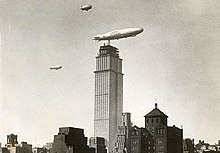Empire State Building - Look Back
Posted on 30th July 2021 at 08:37
How it all began…
In the mid 1820’s the site of the Empire State Building was owned by a John Jacob Astor. In 1893 John Jacob Astor Seniors’s grandson William Waldorf Astor opened the Waldorf Hotel on the site.
Four years later his cousin John Jacob Astor IV opened the 16 storey Astoria Hotel on an adjacent site. At the time the two portions of the Waldorf-Astoria hotel had 1,300 bedrooms and was the largest hotel in the world.
By 1920’s the old Waldorf-Astoria was becoming dated and the affluent socialites had ventured further north than 34th Street, so in 1928 Astor family decided to build a replacement hotel uptown and sold the current dated hotel to Bethlehem Engineering Corporation for $14-$16 million. The hotel closed on May 3rd 1929.

Bethlehem Engineering Corporation originally intended to build a 25-story office building on the Waldorf–Astoria site. The company's president, Floyd De L. Brown, paid $100,000 of the $1 million down payment to start construction with the promise that difference would be paid later. Unfortunately Brown defaulted on the loan and the land was re-sold to Empire State Inc. This included a number of wealthy investors including: Louis G Kaufman, Ellis P Earle, John J Raskob, Coleman du Pont and Pierre S. du Pont. The name came from the state nickname for New York. The group also purchased nearby land so they would have the 2 acres need to build the base. There plan was to construct an 80-storey building which was to be taller then any other building in existence. Empire State Inc contacted an architectural firm Shreve, Lamb and Harmon to create the building designs. An architect within the firm William F. Lamb produced the building drawings in just two weeks.
Planning and Design
The 1916 zoning act forced Lamb to design a structure that incorporated setbacks resulting in the lower floors being larger than the upper floors. Consequently, the building was designed from the top down, giving it a "pencil"-like shape. The plans were devised within a budget of $50 million and a stipulation that the building be ready for occupancy within 18 months of the start of construction.
The original plan of the building was 50 stories, but was later increased to 60 and then 80 stories. Height restrictions were placed on nearby buildings to ensure that the top fifty floors of the planned 80-story, building would have unobstructed views of the city.
While plans for the Empire State Building were being finalised, an intense competition was taking place in New York for the title of “world’s tallest building”. 40 Wall Street and the Chrysler Building were both competing for this distinction and were already under construction when work began on the Empire State Building.
Empire State Inc wanted to have the Empire State Building to be the world's tallest so reviewed the plans and had five floors added as well as a spire. However, due to the projected wind pressure the new floors would need to be set back. On November 18, 1929, they acquired a lot at 27–31 West 33rd Street, adding 23 m to the width of the proposed office building's site. The plans included an observation deck on the 86th-floor roof at a height of 1,050 feet (320 m), higher than the Chrysler's 71st-floor observation deck.

The 1,050-foot Empire State Building would only be 4 feet (1.2 m) taller than the Chrysler Building, Empire State Inc were afraid that Chrysler might try to "pull a trick like hiding a rod in the spire and then sticking it up at the last minute." The plans were revised one last time in December 1929, to include a 16-story, 200-foot (61 m) metal "crown" and an additional 222-foot (68 m) mooring mast intended for airships. The roof height was now 1,250 feet (380 m), making it the tallest building in the world by far, even without the antenna. The addition of the airship station meant that another floor, the now-enclosed 86th floor, would have to be built below the crown; however, unlike the Chrysler's spire, the Empire State's mast would serve a practical purpose. A revised plan was announced to the public in late December 1929, just before the start of construction. By this time the blueprints for the building had gone through up to fifteen versions before they were approved.
Construction
The contractors were Starrett Brothers and Eken, the project was financed primarily by Raskob and Pierre du Pont, while James Farley’s General Builders Supply Corporation supplied the building materials.
Demolition of the old Waldorf–Astoria began on October 1, 1929. Stripping the building down was an arduous process, as the hotel had been constructed using more rigid material than earlier buildings had been. Furthermore, the old hotel's granite, wood chips, and "'precious' metals such as lead, brass, and zinc" were not in high demand resulting in issues with disposal. Most of the wood was deposited into a woodpile on nearby 30th Street or was burned in a swamp elsewhere. Much of the other materials that made up the old hotel, including the granite and bronze, were dumped into the Atlantic Ocean.
The plan was to start construction later that year but, on October 24, the New York Stock Exchange experienced the major and sudden Wall Street Crash marking the beginning of the decade-long Great Depression. Despite the economic downturn, John J Raskob refused to cancel the project because of the progress that had been made up to that point. Raskob, had no stock investments so didn’t suffer financially in the crash. In December 1929, Empire State Inc. obtained a $27.5 million loan so construction could begin. The stock market crash resulted in no demand for new office spaces however construction started as cancelling the project would have resulted in greater losses for the investors.
A structural steel contract was awarded on January 12, 1930, with excavation of the site beginning ten days later before the old hotel had been completely demolished. Two twelve-hour shifts, consisting of 300 men each, worked continuously to dig the 55-foot (17 m) foundation. Small pier holes were sunk into the ground to house the concrete footings that would support the steelwork. Excavation was nearly complete by early March, and construction on the building itself started on March 17, with the builders placing the first steel columns on the completed footings before the rest of the footings had been finished.

Around this time, Lamb held a press conference on the building plans. He described the reflective steel panels parallel to the windows, the large-block Indiana Limestone facade that was slightly more expensive than smaller bricks, and the building's vertical lines. Four colossal columns, intended for installation in the center of the building site, were delivered; they would support a combined 10,000,000 pounds (4,500,000 kg) when the building was finished.
The structural steel was pre-ordered and pre-fabricated in anticipation of a revision to the city's building code that would have allowed the Empire State Building's structural steel to carry 18,000 pounds per square inch (120,000 kPa), up from 16,000 pounds per square inch (110,000 kPa), thus reducing the amount of steel needed for the building. The first steel framework was installed on April 1, 1930. From there, construction proceeded at a rapid pace; during one stretch of 10 working days, the builders erected fourteen floors. This was made possible through precise coordination of the building's planning, as well as the mass-production of common materials. On one occasion, when a supplier could not provide timely delivery of dark Hauteville marble, Starrett switched to using Rose Famosa marble from a German quarry that was purchased specifically to provide the project with sufficient marble.

The scale of the project was massive, with trucks carrying 16,000 partition tiles, 5,000 bags of cement, 450 cubic yards [340 m3] of sand and 300 bags of lime arriving at the construction site every day. There were also cafes and concession stands on five of the incomplete floors so workers did not have to descend to the ground level to eat lunch. Temporary water taps were also built so workers did not waste time buying water bottles from the ground level. Additionally, carts running on a small railway system transported materials from the basement storage to elevators that brought the carts to the desired floors where they would then be distributed throughout that level using another set of tracks. The 57,480 short tons (51,320 long tons) of steel ordered for the project was the largest-ever single order of steel at the time. By June 20, the skyscraper's supporting steel structure had risen to the 26th floor, and by July 27, half of the steel structure had been completed. Starrett Bros. and Eken endeavored to build one floor a day in order to speed up construction.
While construction progressed, the final designs for the floors were being designed from the ground up (as opposed to the general design, which had been from the roof down). On September 10, as steelwork was nearing completion, Smith laid the building's cornerstone during a ceremony attended by thousands. The steel structure was topped out at 1,048 feet (319 m) on September 19, twelve days ahead of schedule and 23 weeks after the start of construction. Workers raised a flag atop the 86th floor to signify this milestone.
The mooring mast for airships was topped out on November 21, two months after the steelwork had been completed. Work on the walls and interior was progressing at a quick pace, with exterior walls built up to the 75th floor by the time steelwork had been built to the 95th floor. The majority of the facade was already finished by the middle of November. Because of the building's height, it was deemed infeasible to have many elevators or large elevator cabins, so the builders contracted a company to make 66 cars that could speed at 1,200 feet per minute
(366 m/min), which represented the largest-ever elevator order at the time.

In addition to the time constraint builders had, there were also space limitations because construction materials had to be delivered quickly, and trucks needed to drop off these materials without congesting traffic. This was solved by creating a temporary driveway for the trucks between 33rd and 34th Streets, and then storing the materials in the building's first floor and basements. Concrete mixers, brick hoppers, and stone hoists inside the building ensured that materials would be able to ascend quickly and without endangering or inconveniencing the public. At one point, over 200 trucks made material deliveries at the building site every day. The Empire State Building was structurally completed on April 11, 1931, twelve days ahead of schedule and 410 days after construction commenced.

Share this post:

